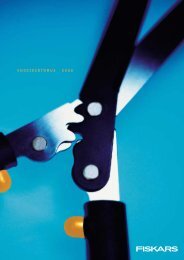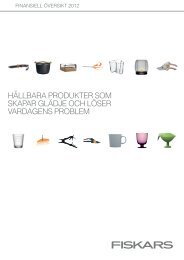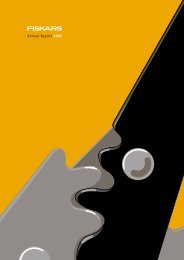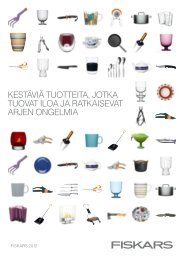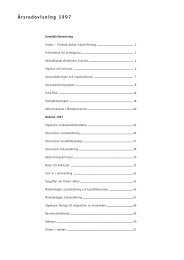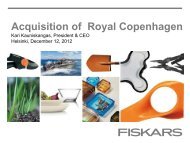FISKARS 1649 â 360 years of Finnish industrial history
FISKARS 1649 â 360 years of Finnish industrial history
FISKARS 1649 â 360 years of Finnish industrial history
You also want an ePaper? Increase the reach of your titles
YUMPU automatically turns print PDFs into web optimized ePapers that Google loves.
Fiskars <strong>1649</strong><br />
Fiskars <strong>1649</strong><br />
Fiskars was one <strong>of</strong> the first companies in Europe to make microwave ovens in 1965–73.<br />
early 1990s, that was characterized by inflation and<br />
repeated devaluations. The metal industry drifted<br />
into a strike <strong>of</strong> its own in 1971, when Fiskars’ plants<br />
were closed for seven weeks<br />
In these external circumstances, the engineering<br />
industry was obliged to reorient itself. New exports<br />
and design at first yielded some impressive successes,<br />
although the overall financial importance <strong>of</strong> these<br />
was not very great. Many companies fragmented<br />
themselves in an attempt to diversify.<br />
Fiskars was among those that embarked on<br />
a policy <strong>of</strong> takeovers in the early 1960s, a policy<br />
that turned out to be ill-considered. Gradually the<br />
corporation’s pr<strong>of</strong>its were eroded and it was forced<br />
into action on stabilization and restructuring. In<br />
those troubled <strong>years</strong> the company’s real property<br />
turned out to be a precious resource. The sale <strong>of</strong><br />
some land in the Tammisaari islands gave the<br />
company a breathing space that was vital for Fiskars<br />
to be able to transform itself.<br />
It was partly because <strong>of</strong> these very problems<br />
that Fiskars embarked as early as 1969 on the<br />
kind <strong>of</strong> radical <strong>industrial</strong> restructuring that<br />
became commonplace elsewhere in the 1990s.<br />
The chairman <strong>of</strong> the board <strong>of</strong> directors, Jacob von<br />
Julin, had the foresight to relinquish the company’s<br />
original business, steel-making, to Ovako Oy Ab.<br />
This rationalization secured Fiskars’ supplies<br />
<strong>of</strong> raw materials for many <strong>years</strong> to come. The<br />
other advantageous terms <strong>of</strong> the deal boosted the<br />
company’s pr<strong>of</strong>its. Åminnefors also did well under<br />
Ovako’s ownership.<br />
Towards a dynamic, international company<br />
Fiskars entered a new period in its development<br />
under Göran J. Ehrnrooth, who served as CEO<br />
between 1974 and 1982 and as Chairman <strong>of</strong> the<br />
Board <strong>of</strong> Directors between 1982 and 2005. This<br />
saw the company establish a presence in the US,<br />
Fiskars axes are made at Fiskars plant in Billnäs.<br />
the world’s most dynamic economy – a move<br />
that proved a success and one that <strong>of</strong>fered a sold<br />
foundation for international expansion, access to<br />
new markets, and valuable experience.<br />
Fiskars’ expansion began with the setting-up <strong>of</strong><br />
a scissors plant in the US in 1977, and was followed<br />
by a series <strong>of</strong> acquisitions <strong>of</strong> consumer product<br />
companies, including Wallace Manufacturing Co.<br />
in 1985, Gerber Legendary Blades, also in 1985, and<br />
Coltellerie Montana in 1989.<br />
The seeds <strong>of</strong> a major factor in Fiskars’ future<br />
success had been sown earlier, largely unknowingly,<br />
during a difficult time for the company, when it<br />
produced its first orange-handled scissors in 1967.<br />
Production was transferred to larger premises<br />
in Fiskars the following year, and construction<br />
<strong>of</strong> a new scissors plant in Billnäs followed very<br />
44<br />
45



